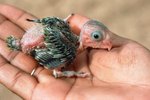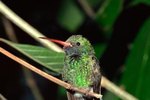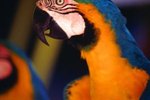
The development rate of baby birds varies according to the species and environment in which the bird lives. For example, precocial birds such as quail and ducks, have a relatively high level of independence from birth. These are typically ground-dwelling and do not have the protection of a nest. These birds are born with open eyes and full vision. Altrical birds are born in nests, typically with closed eyes, and take longer to develop.
Eyes Closed
Most nest-dwelling birds hatch with their eyes closed. They are relatively immobile after hatching and require their mother to assist them with most tasks, such as feeding. They are naked, save for only a thin layer of down, so require a nest and the presence of their fellow chicks for warmth. Precocial chicks typically open their eyes within a few hours of hatching. Since they are ground-dwellers, they are at high risk of predation at this early stage in their life.
Eyes Beginning to Open
At around day three or four of a young bird’s life, the eyes may begin to open. However, some chicks may take a little longer to open their eyes than others, even chicks that hatched at the same time in the same nest. Even though the eyes may be beginning to open, the chick’s visibility
Eyes Fully Open
By day six of the bird’s life, his eyes will typically be fully open and his vision will be completely developed. This is a milestone in the life of a baby bird, as vision opens up a whole new world of possibility. With vision, he can now explore his surroundings, setting the foundation for further development.
Chick Development
Once the eyes are open, the chick’s instincts will begin to take effect. He will display flinching and cowering reactions to visual stimuli and will begin to experiment with the use of his wings, primarily for balance as he walks around. Once fully feathered after week two, the chick will begin to instinctively preen himself, using his beak.
References
Photo Credits
-
Jupiterimages/Photos.com/Getty Images
Writer Bio
Simon Foden has been a freelance writer and editor since 1999. He began his writing career after graduating with a Bachelors of Arts degree in music from Salford University. He has contributed to and written for various magazines including "K9 Magazine" and "Pet Friendly Magazine." He has also written for Dogmagazine.net.



